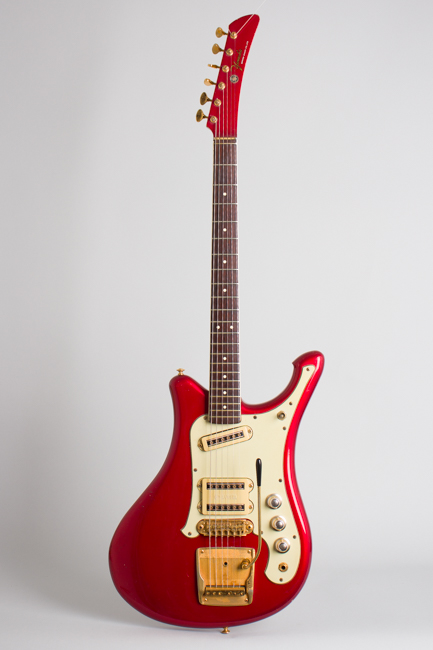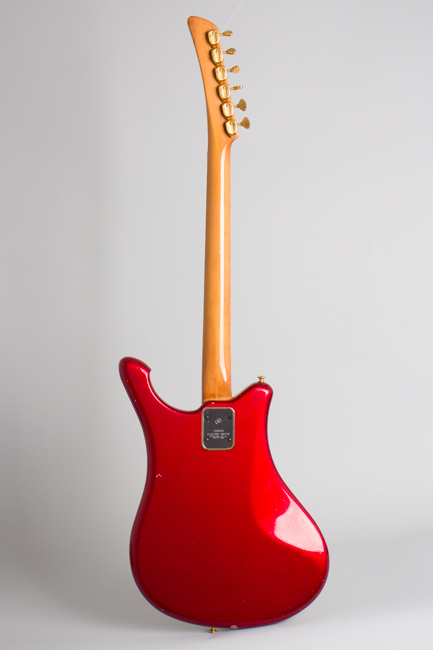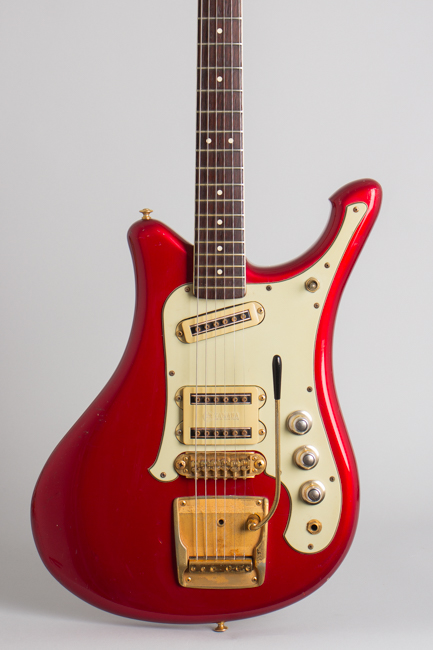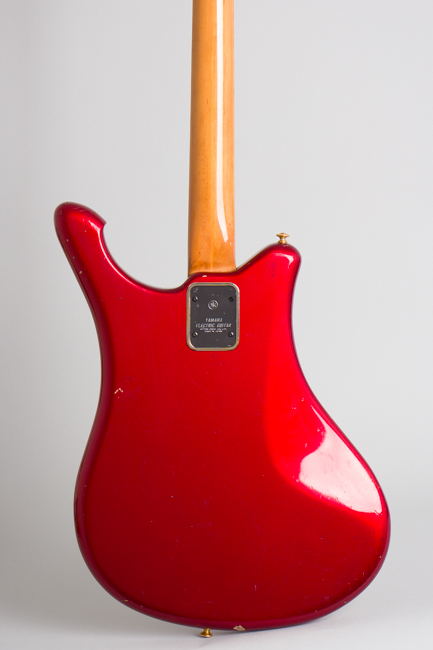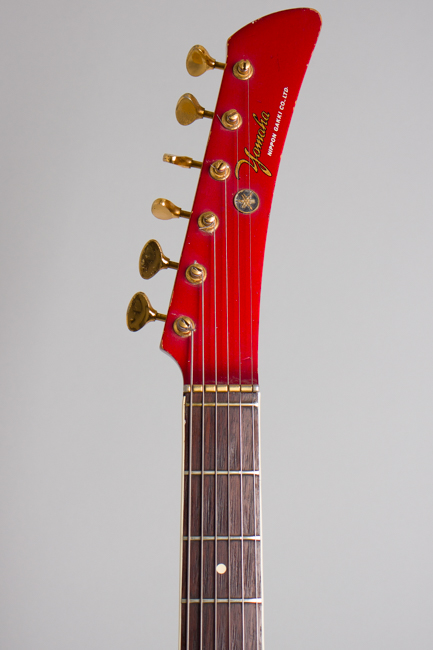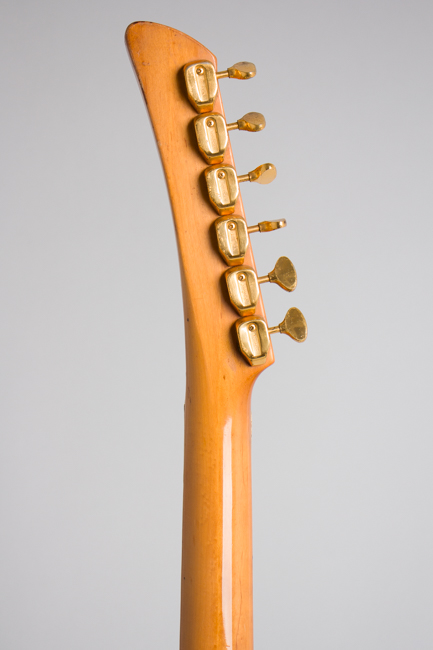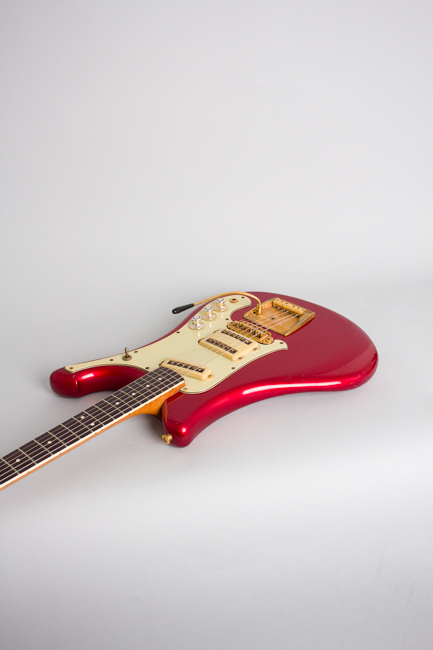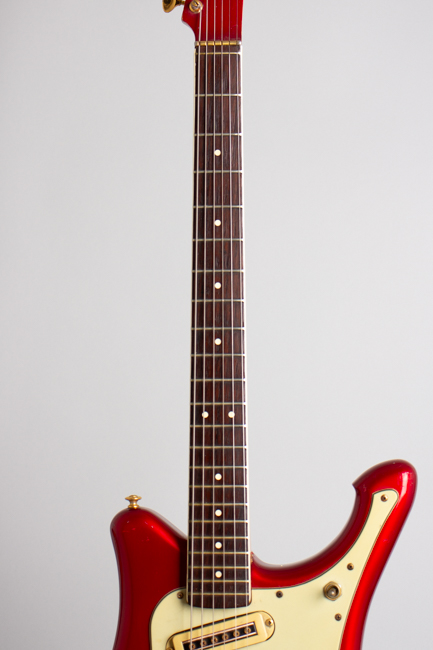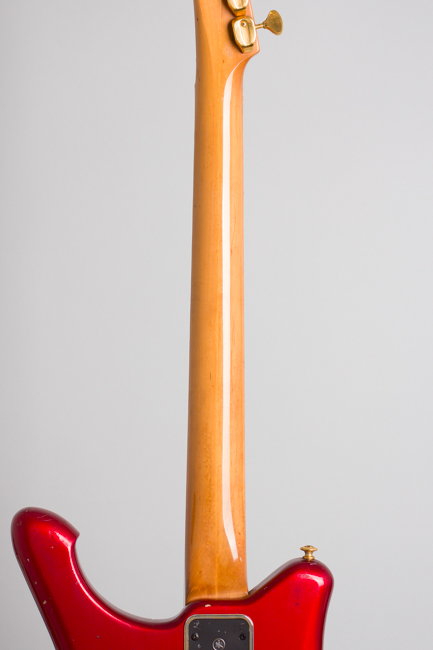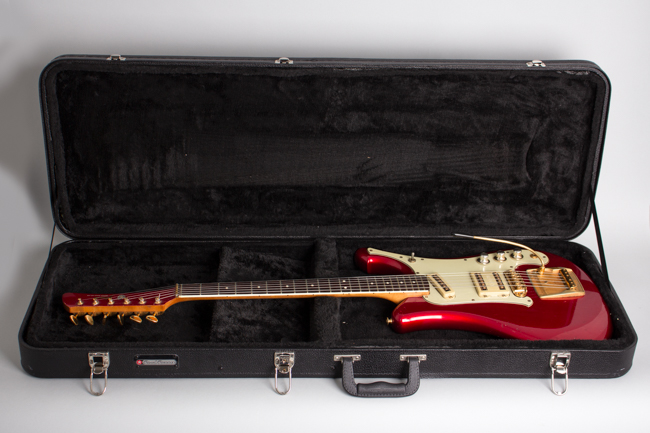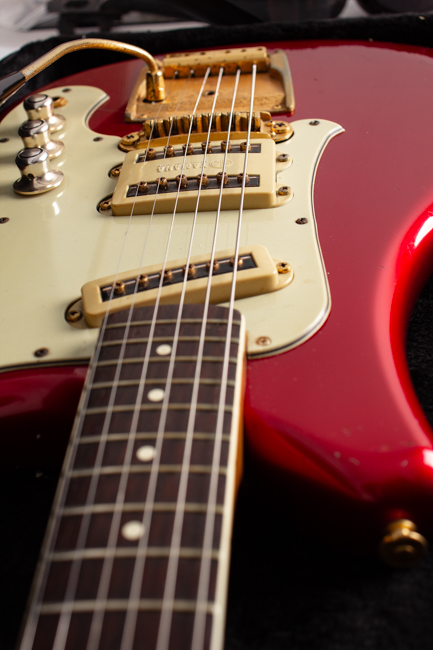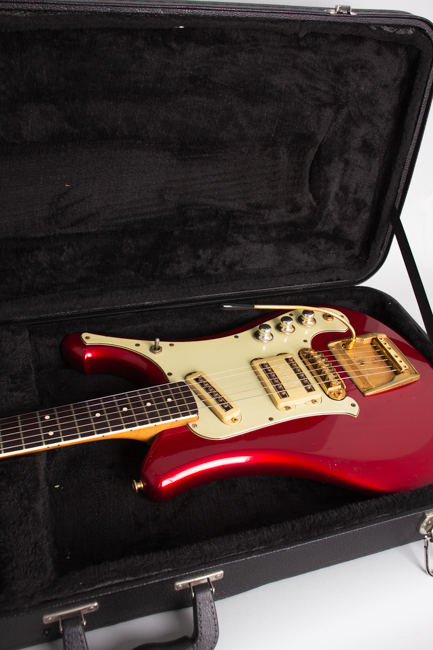Yamaha SG-7 Solid Body Electric Guitar (1966-7)
This item has been sold.
Item # 11960
Prices subject to change without notice.
Yamaha SG-7 Model Solid Body Electric Guitar (1966-7), made in Hamamatsu, Japan, serial # 2247, Candy Apple Red lacquer finish, hardwood body, maple neck with rosewood fingerboard, black tolex hard shell case.
This Yamaha SG-7 was this venerable Japanese company's top-of-the-line solidbody in the 1960s, gold plated, super flashy and by any standard pretty much the finest electric guitar made in Japan up to that point. The design is highly original and wildly eccentric, but the instrument is built to a much higher quality and design standard than any other Japanese electrics from this period, many of which were spotty at best. Yamaha was a highly diversified company but all of their products manifested a commitment to quality and the highest grade workmanship.
The company launched the "SG" solid electric line in 1966, having already made inroads in the global acoustic guitar market. The range was distinguished by a visually striking progression of highly asymmetrical bodies, this flagship SG-7 and the similar SG-5 being perhaps the most unusual. In comparison to some of the lower end models, the SG-7 rather looks as if it had been originally designed the other way round and at the last minute flipped over! The elongated sculpted horn on the treble cutaway side balances a large offset body curve at the other end, both of which would make more visual (and ergonomic) sense the other way round! The dynamic but oddball look is enhanced by a very long thin headstock reminiscent of a hockey stick and/or samurai sword; strikingly modern for 1966; it would not look out of place on a 1990s guitar!
The SG-7 was not primarily intended for export, but aimed at Japan's domestic market, then in an electric guitar frenzy at levels even exceeding the US. Yamaha solicited design input from Takeshi Terauchi, one of the country's leading young rock'n'roll players of the day. His hot instrumental style was heavily inspired by the Ventures, down to the black Mosrite he played with the Blue Jeans, his signature band. Yamaha was really the only company in Japan at the time that could offer a similar quality instrument, so the endorsement worked both ways.
Probably due to Terauchi's input the SG-7 inherited some Mosrite-esqe elements, particularly a slim neck with a zero fret and metal nut. The serial number was stamped in the fingerboard exactly as Semie did it in California! The vibrato tailpiece is a unique and very well engineered design with an internal spring mechanism and elaborate roller-saddle bridge. This excellent design has a smooth and wide-ranged feel that is rather Mosrite-like, even arguably superior in operation. One wonders if the "reversed" body with its elongated treble-side horn and swooping upper curve was a nod to Mosrite as well.
Even considering the off-kilter look the SG-7's most interesting element might well be the pickup configuration. The angled single-coil at the neck is yet another Mosrite-like touch, but the apparent giant humbucker in the bridge position looks like nothing else from 1966. The catch is, it's not a humbucker at all but two separate single-coil units mounted under one large cover, so this is actually a 3-pickup guitar. The pickups are wired to a three-way switch with master volume and tone controls. The third center knob is another cool innovation, a blend control that rolls in the middle pickup. It's actually a very sensible layout, arguably better than either Fender or Gibson's 3-pickup systems.
The 22-fret maple neck is bolted on; hidden under a decorative rear plate the four neck attachment screws surround a discreet truss-rod access point, an idea borrowed from Burns. The beautiful Candy Apple Red finish is on a level with Fender and Mosrite, and the green nitrocellulose pickguard appears to be the same material both companies used. The SG-7 was also offered in white, metallic blue and sunburst. The gold plating is also extremely well done, heavier and more durable than most American equivalents.
The SG-7 and its lower-end siblings were never officially sold in the US market, so this is a VERY rare guitar here. The entire original Yamaha SG line was discontinued by 1971, replaced by a line of well-crafted but far more conventional-looking guitars with none of its exuberant style. Despite a wildly eccentric profile this is a serious instrument, at least equal to many European and even American guitars of the era. It is an excellent player and one of the most distinctive guitars of the 1960s both visually and sonically.
Overall length is 40 3/4 in. (103.5 cm.), 13 1/2 in. (34.3 cm.) wide at lower bout, and 1 3/4 in. (4.4 cm.) in depth, measured at side of rim. Scale length is 24 3/4 in. (629 mm.). Width of nut is 1 9/16 in. (40 mm.).
This gleaming red example of the rare gold-plated "Flying Samurai" shows some general play wear overall but remains all original and in excellent playing condition. There are numerous nicks, scrapes and dings to the body finish, most heavily on the back with some buckle wear and a couple of larger chips on the edges. The back of the neck is relatively clean with only some light marks and a couple of feelable dinks.
The fittings and electronics remain all original and relatively clean for a nearly 50 year old instrument with some typical occlusion and loss to the gold plating; even the original trem arm is present. The rosewood fret board and original frets show only very light wear, and the frets appear to have been lightly recrowned in the past. One small piece of neck binding was neatly replaced. This is a great playing and sounding example of this eccentric Japanese masterwork, a model seldom encountered on this side of the Pacific. It resides in a modern rectangular black Tolex hard case that fits better than most! Overall Excellent - Condition.
This Yamaha SG-7 was this venerable Japanese company's top-of-the-line solidbody in the 1960s, gold plated, super flashy and by any standard pretty much the finest electric guitar made in Japan up to that point. The design is highly original and wildly eccentric, but the instrument is built to a much higher quality and design standard than any other Japanese electrics from this period, many of which were spotty at best. Yamaha was a highly diversified company but all of their products manifested a commitment to quality and the highest grade workmanship.
The company launched the "SG" solid electric line in 1966, having already made inroads in the global acoustic guitar market. The range was distinguished by a visually striking progression of highly asymmetrical bodies, this flagship SG-7 and the similar SG-5 being perhaps the most unusual. In comparison to some of the lower end models, the SG-7 rather looks as if it had been originally designed the other way round and at the last minute flipped over! The elongated sculpted horn on the treble cutaway side balances a large offset body curve at the other end, both of which would make more visual (and ergonomic) sense the other way round! The dynamic but oddball look is enhanced by a very long thin headstock reminiscent of a hockey stick and/or samurai sword; strikingly modern for 1966; it would not look out of place on a 1990s guitar!
The SG-7 was not primarily intended for export, but aimed at Japan's domestic market, then in an electric guitar frenzy at levels even exceeding the US. Yamaha solicited design input from Takeshi Terauchi, one of the country's leading young rock'n'roll players of the day. His hot instrumental style was heavily inspired by the Ventures, down to the black Mosrite he played with the Blue Jeans, his signature band. Yamaha was really the only company in Japan at the time that could offer a similar quality instrument, so the endorsement worked both ways.
Probably due to Terauchi's input the SG-7 inherited some Mosrite-esqe elements, particularly a slim neck with a zero fret and metal nut. The serial number was stamped in the fingerboard exactly as Semie did it in California! The vibrato tailpiece is a unique and very well engineered design with an internal spring mechanism and elaborate roller-saddle bridge. This excellent design has a smooth and wide-ranged feel that is rather Mosrite-like, even arguably superior in operation. One wonders if the "reversed" body with its elongated treble-side horn and swooping upper curve was a nod to Mosrite as well.
Even considering the off-kilter look the SG-7's most interesting element might well be the pickup configuration. The angled single-coil at the neck is yet another Mosrite-like touch, but the apparent giant humbucker in the bridge position looks like nothing else from 1966. The catch is, it's not a humbucker at all but two separate single-coil units mounted under one large cover, so this is actually a 3-pickup guitar. The pickups are wired to a three-way switch with master volume and tone controls. The third center knob is another cool innovation, a blend control that rolls in the middle pickup. It's actually a very sensible layout, arguably better than either Fender or Gibson's 3-pickup systems.
The 22-fret maple neck is bolted on; hidden under a decorative rear plate the four neck attachment screws surround a discreet truss-rod access point, an idea borrowed from Burns. The beautiful Candy Apple Red finish is on a level with Fender and Mosrite, and the green nitrocellulose pickguard appears to be the same material both companies used. The SG-7 was also offered in white, metallic blue and sunburst. The gold plating is also extremely well done, heavier and more durable than most American equivalents.
The SG-7 and its lower-end siblings were never officially sold in the US market, so this is a VERY rare guitar here. The entire original Yamaha SG line was discontinued by 1971, replaced by a line of well-crafted but far more conventional-looking guitars with none of its exuberant style. Despite a wildly eccentric profile this is a serious instrument, at least equal to many European and even American guitars of the era. It is an excellent player and one of the most distinctive guitars of the 1960s both visually and sonically.
Overall length is 40 3/4 in. (103.5 cm.), 13 1/2 in. (34.3 cm.) wide at lower bout, and 1 3/4 in. (4.4 cm.) in depth, measured at side of rim. Scale length is 24 3/4 in. (629 mm.). Width of nut is 1 9/16 in. (40 mm.).
This gleaming red example of the rare gold-plated "Flying Samurai" shows some general play wear overall but remains all original and in excellent playing condition. There are numerous nicks, scrapes and dings to the body finish, most heavily on the back with some buckle wear and a couple of larger chips on the edges. The back of the neck is relatively clean with only some light marks and a couple of feelable dinks.
The fittings and electronics remain all original and relatively clean for a nearly 50 year old instrument with some typical occlusion and loss to the gold plating; even the original trem arm is present. The rosewood fret board and original frets show only very light wear, and the frets appear to have been lightly recrowned in the past. One small piece of neck binding was neatly replaced. This is a great playing and sounding example of this eccentric Japanese masterwork, a model seldom encountered on this side of the Pacific. It resides in a modern rectangular black Tolex hard case that fits better than most! Overall Excellent - Condition.
